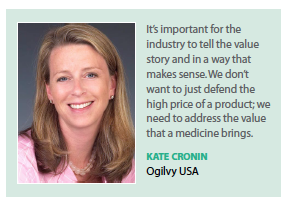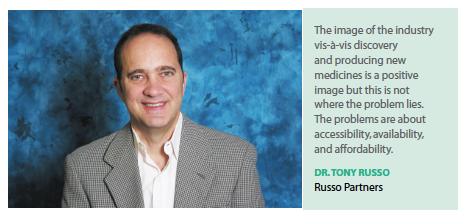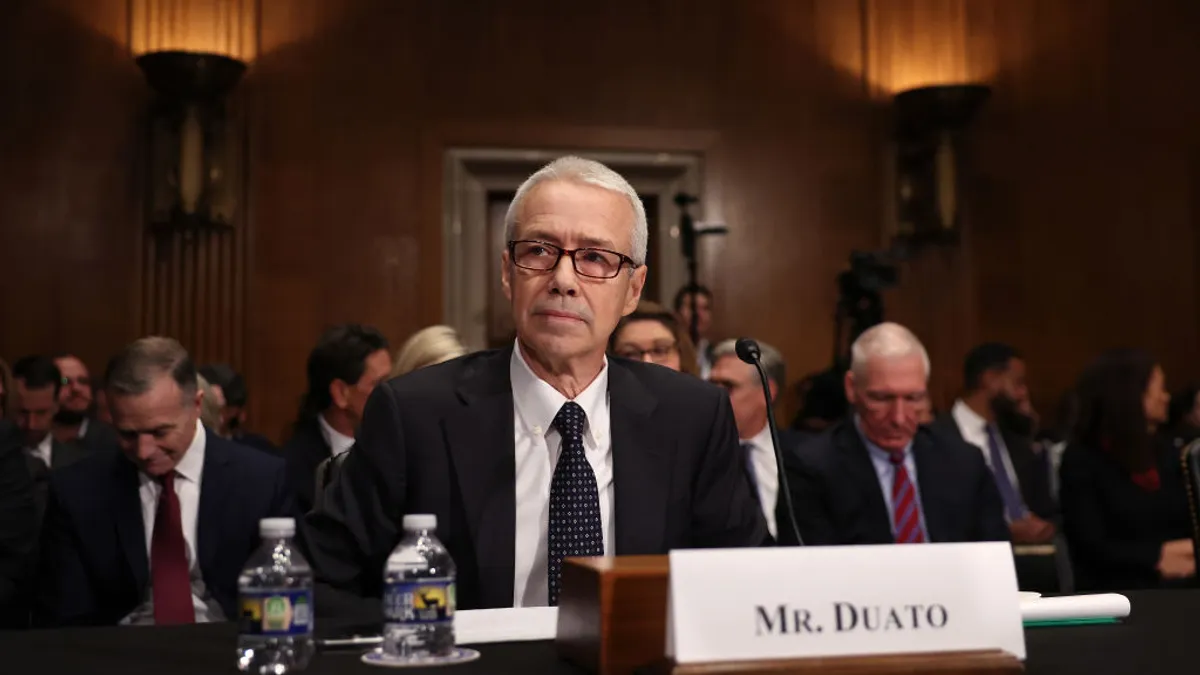We’ve all seen the commercials. They feature patients living with serious diseases and the researchers working to develop innovative therapies. These ads focus on the science and the breakthroughs being made in medicine. They end with what looks like a genetic analysis giving way to the words America’s Biopharmaceutical Companies.
The commercials aim to showcase the industry’s researchers who are driving cutting-edge advances  in science. The Pharmaceutical Research and Manufacturers of America (PhRMA) launched the campaign, GoBoldly, in January 2017 as a national, multi-year advertising and public affairs initiative.
in science. The Pharmaceutical Research and Manufacturers of America (PhRMA) launched the campaign, GoBoldly, in January 2017 as a national, multi-year advertising and public affairs initiative.
The campaign includes TV, print, digital, and radio advertising. A website, GoBoldly.com, provides visitors with more information about the topics and themes featured in campaign advertisements, and a redesigned Innovation.org website provides information about advances in biopharmaceutical innovation.
One such series of ads called New World features some of the breakthroughs in science being discovered by biopharmaceutical researchers, highlighting the new world of science in which immunotherapy is replacing chemotherapy; how researchers attack the causes of disease, not just the symptoms; and how medicines can now be tailored for the individual patient.
Another series titled Together features the stories of researchers alongside patients benefiting from innovation. One ad tells the story of Jessica, a cancer researcher turned cancer patient, and Maysoun, a scientist developing new therapies for types of breast cancer resistant to other forms of treatment. Other TV ads in the Together series feature the stories of Brian, who has Alzheimer’s disease, and Samantha, a scientist researching new treatments for Alzheimer’s, as well as Nicole, who has a family history of heart disease and who is now battling the disease herself, and Paul, a heart disease researcher.
“The GoBoldly campaign has done a very good job of providing researchers with the recognition  that they deserve for the incredibly valuable work that they do for patients each day," says Robert Stanislaro, managing director, FTI Consulting. “It’s been particularly effective at communicating what inspires these researchers day in and day out."
that they deserve for the incredibly valuable work that they do for patients each day," says Robert Stanislaro, managing director, FTI Consulting. “It’s been particularly effective at communicating what inspires these researchers day in and day out."
He points to the Innovation Talk podcasts as being particularly effective at explaining how medicines are developed. “Many of us forget that some of these researchers are sometimes patients as well, and this initiative has been an effective way to humanize what researchers do every day."
The GoBoldly campaign is incredibly important to provide consumers with an understanding of what the biopharmaceutical industry does to advance new treatments, new cures, new innovations, says Lynn Hanessian, chief strategist for the Chicago health practice at Edelman. “GoBoldly is providing broad exposure for the industry so that when people become actively engaged in their health, they have a perception and understanding of what the industry does."
Kate Cronin, managing director, Health & Wellness, Ogilvy USA, says the GoBoldly campaign humanizes the industry. “It’s been a challenge for the pharma industry to personalize what it does for people who aren’t as familiar with research," she says. “The ads are creatively well done, and I think they’re emotional."
Creating a connection with consumers has always been challenging because people don’t have the ability to experience pharmaceutical brands in the same way they do with consumer products.
“For consumers, the science feels very remote because researchers are in a lab developing a product that can take several years to reach them," Ms. Cronin says. “Whatever companies can do to get closer to their consumer base is positive."
The GoBoldly campaign also includes Do Not Go Gentle, combining the iconic poem by Dylan Thomas and Cells, highlighting exciting scientific advances that are happening at the cellular level.
 The campaign includes a virtual reality video highlighting innovation and a new era of groundbreaking advancements. The video takes viewers inside a biopharmaceutical lab, where amazing discoveries are being made in science through the use of genomics-based research. The video provides valuable insights into the real-life laboratory experience, and how the new era of medicine is helping power scientific advancements that improve patients’ lives.
The campaign includes a virtual reality video highlighting innovation and a new era of groundbreaking advancements. The video takes viewers inside a biopharmaceutical lab, where amazing discoveries are being made in science through the use of genomics-based research. The video provides valuable insights into the real-life laboratory experience, and how the new era of medicine is helping power scientific advancements that improve patients’ lives.
In February 2017, PhRMA launched a convention titled: Through the Microscope: Examining Modern Medicine. The event aimed to address the transformation of patient care and the science that has revolutionized medical breakthroughs, new treatments and technologies, as well as the investments needed for future innovation.
“We’re encouraged by the progress of these campaigns in their first year," says Holly Campbell, deputy VP, public affairs PhRMA. “GoBoldly has helped to shape a better conversation about the amazing science happening in biopharmaceutical company labs right now."
She points to the GoBoldly website, where PhRMA highlights the medical innovations occurring. “We cannot take for granted the incredible progress we are making, policy solutions we support to improve patient affordability, and the bold commitment our members have made to the research and development of new treatments and cures," Ms. Campbell says.
Ms. Hanessian says she would like to see the campaign continue to evolve to provide information in a wide range of formats and content and provide opportunities to have direct engagement with consumers.
GoBoldy’s Impact on the Industry’s Reputation
In various surveys assessing reputation, the pharmaceutical industry fares poorly. In a Gallup survey in August 2017 looking at how positively or negatively industries are perceived, the pharma industry ranked second to last, with only the federal government faring worse.
In the most recent Reputation Institute’s U.S. RepTrak ranking of corporate reputation, no healthcare company was in the top 10. According to the survey, the most successful companies demonstrate brand strength, increasingly founded on the delivery of a brand promise, yield higher reputation and greater support among stakeholders.
While governance and citizenship — especially on the merits of fairness, ethics, positive influence on society, and importance of products/services — have increased as reputation drivers in 2018 (collectively contributing to 51.9% of reputation), the relative importance of overall company performance has declined, with fewer companies perceived as embodying a sense of sincerity and genuine caring, with the absence of authenticity fueling doubt among stakeholders.
The RepTrak index this year finds that the pharmaceutical industry’s score has gone down almost eight points since last year. The Pharma RepTrack report in 2017 by the Reputation Institute indicated pharma companies would benefit from more communication as overall familiarity is still low, and the general public is asking for more information about the companies.
And in the Edelman Trust Barometer, U.S. consumers’ trust in healthcare fell 9 points last year. Every subsector of healthcare — hospital and clinics, consumer health, biotech/life sciences, insurance, and pharmaceuticals — dropped, according to Ms. Hanessian.
“This is something we have not seen before, and it’s something that I think should be very worrying to all of us who work in the industry," she says. “This year was a year of incredible disruption across all industries, across all sectors of U.S. society in particular. There was so much discourse, distrust, and worry that surfaced, which has led to healthcare in the United States being the lowest trusted sector."
Ms. Hanessian says this drop in the healthcare trust factor may be because consumers don’t understand the biopharma industry. “Consumers think of biotech as the place of innovation," she says. “When we asked the question about where do new treatments come from, 44% of respondents said biotech, and only 9% said the pharmaceutical industry. We also asked if consumers know the difference between biotech life sciences and pharmaceuticals and nearly 20% said they weren’t sure."
Our PR leaders say any change in the industry’s reputation is not likely to happen overnight.
“This is a campaign that has a long-term strategy; it is not a tactic that’s going to be able to shift perceptions overnight," Mr. Stanislaro says.
Ms. Cronin says public relations can move the needle on the perception of the industry, and by working closely with patient advocacy organizations the industry can showcase how innovation is changing lives on a regular basis. “Looking at different avenues to reach audiences is important," she says. “The idea is not just about pushing information out but finding ways to engage with an audience base. There are a lot of ways to engage with stakeholders."
To engage consumers and move the needle on reputation, companies need to create a surround-sound approach, Ms. Cronin says. “There are ways that we can have a two-way dialogue with stakeholders, which can be through social media or through events. This can be challenging because we’re a highly regulated industry, but we need to engage or we are just pushing information out."
The Pricing Issue
The image of the industry vis-à-vis discovery and producing new medicines is a positive image, but that’s not where the problem lies, says Tony Russo Ph.D., chairman and CEO, Russo Partners.
“The problems are about accessibility, availability, and affordability," he says. “We’re really at a breaking point. Our current systems can’t handle the burden of the cost of medicines."
He says people would agree that the pharmaceutical industry is producing important new medicines that are life saving and in some cases curing disease.
“The concern that people have is whether they can afford those medicines," he says. “The campaign talks about immunotherapy. It talks about personalized medicine. But those are treatments that come with high price tags, and I believe that the patients who see these ads are concerned. Can I afford a drug that costs six figures? Will my insurance pay for the medicine? How can I get access to that drug?
“These are very difficult questions to answer," Dr. Russo continues. “Addressing these concerns with a certain amount of candor is important and I don’t know that an ad campaign is going to solve these issues. The industry and the government need to coalesce and they need to address these issues."
The Edelman Trust Barometer tried to assess whether consumers understood the concept of cost of prescription medications.
“People in the United States believe that most of the responsibility for the high cost of healthcare comes from the pharmaceutical industry, and in none of the countries that we looked at was biotech seen as playing this role," Ms. Hanessian says. “Price continues to be a hot-button issue and it’s an area that will require a persistent and ongoing initiative across all stakeholders. Cost is not just a patient issue but one for the health system overall."
Ms. Hanessian says the most important thing is for companies to think about the whole patient.
“I hope that the industry continues to evolve to provide consumers with the type of support and information necessary as they go on their personal health journeys and live their lives with an illness or a condition."
PhRMA’s Ms. Campbell says earlier this year, as part of the “Let’s Talk About Cost" campaign, PhRMA launched LetsTalkAboutCost.org, a national consumer-facing website to provide consumers with easy-to-understand information about the cost and coverage of medicines.
“The new site uses an interactive quiz format to educate consumers about medicine spending and pricing trends, insurance coverage of medicines, the biopharmaceutical supply chain, the role of hospital markups, and other healthcare cost issues," she says.
Specifically, the GoBoldly campaign has launched ads that focus on insurance company efforts to limit access to pharma company co-pay programs. In 2018, many insurers and PBMs implemented copay accumulator programs changing how copay assistance for some medicines applies to patient cost sharing. According to PhRMA, the insurer programs block copay assistance from counting toward a patient’s deductible or out-of-pocket maximum.
“The Let’s Talk About Cost campaign has changed the conversation about the cost of medicines by creating a better understanding of what patients pay at the pharmacy counter, who determines what they pay, and the impact of middlemen such as pharmacy benefit managers and hospitals," Ms. Campbell says.
Additionally, in May PhRMA launched “Let’s Talk About Medicare" as a way to start the discussion around affordability in Medicare Part D. This part of the campaign aims to have a larger conversation around costs to facilitate a discussion about solutions to strengthen the Part D program.
Today, more than 40 million people are enrolled in Medicare Part D. But many seniors are increasingly facing high out-of-pocket costs and fluctuating costs at the pharmacy. While nearly nine out of 10 seniors are satisfied with their coverage, they do believe it could be made better for some.
A recent poll shows that 89% agree the program could work better by making prescription drug costs more affordable and predictable for seniors. Further, by a 2 to 1 margin, they prefer the idea of reducing out-of-pocket costs for medicines over reducing premiums in Part D.
Mr. Stanislaro says he would like to see the next phase of the campaign address how biopharma companies are driving down the price of medicines.
“The Let’s Talk About Cost campaign is a very good start at addressing this issue and providing different perspectives, but in its second phase, the GoBoldly campaign might look to inform how companies are addressing the cost issue," he says. “Medication cost is a complicated issue given the multitude of stakeholders that are involved," Mr. Stanislaro says. “Forums that reach out to patients to help understand their challenges when it comes to drug pricing would be a helpful piece of this initiative."
Ms. Cronin says innovation and cost — meaning value — go hand in hand. “It’s important for the industry to tell the value story and in a way that makes sense. We don’t want to just defend the high price of a product, we need to address the value that a medicine brings."
But Ms. Cronin adds that the industry is changing so quickly, that PhRMA will need to stay ahead of the curve in the market dynamics.(PV)



















